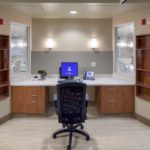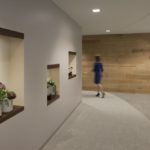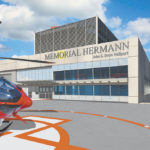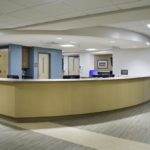By 2020, behavioral health disorders will surpass all physical diseases as a major cause of disability worldwide. In the United States, the Substance Abuse and Mental Health Services Administration estimates that nearly 43.7 million adults ages 18 and older have a mental illness and more than 20 million people ages 12 and up have a substance use disorder. Read More …
VA Video Connect Expands Veterans’ Access to Healthcare
More and more veterans are receiving healthcare treatment virtually, thanks to efforts by the U.S. Department of Veterans Affairs to expand telehealth.
One of the recent successes has been with VA Video Connect, which allows veterans to connect with their healthcare teams over live video from a computer, tablet or smartphone from the comfort Read More …

How Human Experience Informs Design
Who will use this space?
Too often, architects design buildings without looking the building users in the eyes, and without understanding who the users really are. What type of family do they come from? What is their ethnicity or cultural background? What are their likes, dislikes, fears and values? We often design for the average or the generic, such as “the children” or “the patients” or “the clinicians.” If that’s not enough, we try to be more specific: “behavioral health patients” or “patients with autism.” Even then, we often fall short. Instead of designing a treatment space for a young patient with autism, let’s design a treatment room for Alex. Instead of designing a waiting area for a patient suffering from depression, let’s design a waiting area for Derrick. Let’s design for real people. Read More …

Top 6 Design Practices for Patient Care Units
Improving patient care through efficient medical-surgical unit design solutions
With increasing emphasis on quality, safety and profitability in today’s healthcare marketplace, industry leaders are intensifying their focus on design that supports effective operations. The objectives are to maximize staff efficiency by right-sizing and “right-fitting” patient care units with layouts that are efficient for nurses and the care team, to provide safe environments for patients and to foster collaborative team environments.
Design solutions for new and renovated medical-surgical units may be unique for each facility due to site and existing structure and footprints; however, they should enable efficient patient care by incorporating these key considerations:
1) Optimize efficiency
Efficient flow and convenient access for common staff support areas, such as supply and medication rooms, is important to reduce caregiver walking distances. As one nurse manager stated, nurses often spend excessive “sneaker time” walking for supplies and equipment that are not located close to where they are needed.
The most common “hunting and gathering” trips that nurses make are for supplies and medications. These support areas should ideally be located within 40 to 50 feet from the farthest patient room on the unit. A reliable benchmark is to have one medication room per 12-16 patient rooms. Even if routine medications are secured in drawers in patient rooms, they still need to be supported by medication rooms for controlled and refrigerated drugs. Nourishment rooms near medication rooms are helpful for staff when medications need to be administered with food.
Healthcare planners and designers have multiple options to improve efficiency when considering supplies. Nurse servers, or bedside storage casework, provide caregivers access to needed supplies in the patient room. The design goal is to facilitate access to most commonly used supplies while avoiding excess inventory. A good rule of thumb is the 80/80 rule, where 80 percent of supplies used to treat 80 percent of patients are stored closest to the point of care. There are a variety of access options for supplies and medications: corridor access only, patient room access only or a pass-through from the corridor to the patient room. During the planning phase, calculate the walking distance for common trips, such as medication and supply rooms, soiled holding and nourishment areas. These can be graphically represented prior to design and organized based on projected use and walking distance goals of the organization.
Elevator placement is also important for staff and material flow, as well as for visitors. A central location that is equidistant from two or more units is ideal. Service elevator placement should also consider the flow of materials to the unit and removal of soiled linens and trash in an off-stage path.
2) Unit size + space considerations
The ideal unit size varies based on service lines, patient population and size and type of the facility. The unit should be large enough to keep staff productive (24-32 beds for a medical-surgical unit), while not so large that it creates long walking distances. Units with too few rooms are inefficient from a staffing perspective. It is an important safety consideration to have enough staff on the unit to provide peer support and backup. Considering the average nurse to patient ratios of 1:5, 24 beds allows for four caregivers to be present when the unit is 85 percent occupied, which is a typical occupancy goal.
Adjoining units offer the opportunity to share spaces such as staff lounges, family waiting areas and conference rooms. For example, a hospital in the central U.S. planned their medical-surgical units on a 48-bed floor with two adjoining 24-bed units each organized in 12-bed “neighborhoods.” Each of the neighborhoods has its own supply and medication rooms, while conference rooms, administrative space and centrally located public and service elevators serve the entire floor. Getting the unit size right is important, but effective layout is key to improving operations.
Unit size, or the perception of unit size, may be unintentionally altered by design, especially exterior wall features. For example, elevators, stairwells and lounges placed on outside walls, between rooms within a unit, create a break in the contiguous flow of patient rooms, which impacts staffing flexibility.
3) Visibility
Providing visibility to patient rooms and to other members of the care team is another important safety consideration. To foster visibility, it is important to avoid blind corners and isolated rooms. With higher-acuity patient populations today, care team stations with views to groups of rooms and substations between rooms allow nurses to monitor and observe their assigned patients while working from documentation areas.
Peer-to-peer visibility on the unit should not be underestimated. This is especially important when nurses are mentoring newer team members who need team support. Design that fosters visibility is also important at night, when fewer staff are present.
4) Staff support spaces
Natural daylight is a requirement in patient rooms. However, the staff workspaces often receive less natural light as exterior walls with windows for patient rooms take precedence in design space. Research has demonstrated that natural light improves well-being and mood for patients, family members and staff. Daylighting options include windows at the ends of corridors to allow light into the unit and borrowed light from other exterior windows. This also aids in wayfinding and orientation.
With trends toward more open visitation policies, families spend more time in patient rooms, thus large waiting areas become wasted space. While some visitor waiting space is appropriate for families to decompress, space on units can be better allocated to staff lounges, replacing windowless break rooms and allowing the staff a chance to connect with the outside world and relieve stresses of their jobs.
In addition to calming lounges with outdoor views, staff can benefit from small, solitary focus or retreat rooms, with comfortable chairs, that allow for rest and personal decompression. hese spaces are especially important for staff working long shifts. Providing quiet places where they can take a short power nap can make a significant difference. Spa-like amenities such as music, artwork and calming finishes with relaxing colors and materials add to a soothing environment. The same design themes can carry over into public spaces, where family members can go when they need a moment to gather their thoughts amidst the demands of supporting loved ones.
5) Care team collaboration spaces
What has been known as the nurse station is now the care team collaboration station, in keeping with the culture of a multidisciplinary care collaboration model. For example, in a 24-bed unit, there may be two care team collaboration stations, each accommodating 6-8 spaces for nurses, providers, case managers, dieticians and other members of the care team. These spaces are typically not assigned but are flexible enough so that staff can work individually or consult as a team.
Acoustical privacy should be provided within the care team stations for private conversations. This can be accomplished through small touchdown stations with sliding doors or small conference areas deeper into the care team station.
6) Documentation
Patient medical records are another area where privacy is critical. Patient charts are electronic today, which allows more streamlined processes for accessing them. This can be done in multiple locations: at the bedside, at care team stations and in corridor alcoves. Between-room charting alcoves have become more popular as electronic medical records have taken hold.
The key to efficient utilization of electronic medical records is to create redundant locations in which charting can occur. In the patient-centric approach, the emphasis will always be on bedside charting, which increases face time with patients. From there, charting may move to an alcove outside the room, from which the patient can be observed. These are especially useful for patients who need closer observation, such as those at risk of falls. Additional charting may take place at the care collaboration station, or even in staff lounges. From a design perspective, the most significant challenge is to avoid creating complex spaces that are inflexible, don’t fit the needs of staff and, as a result, don’t get used and ultimately require renovation.
Making the care delivery space easy to work in and move through requires future-focused detailed planning before design and construction. Think through operations, use Lean concepts, know what equipment will be used on the unit and plan storage spaces to keep clutter out of hallways. Keep up to date on new technology and design to accommodate future changes. Don’t design around how the units function today, but around how they should ideally function in the future for maximum efficiency. In an increasingly competitive marketplace, industry leaders are intensifying their focus on efficient operations that synthesize these key factors to create the ideal medical unit design. The result will be money saved by planning it right the first time, time saved for staff and visitors and greater patient satisfaction.

Family Involvement in Care
Accommodating communication, participation in the patient room
The therapeutic benefit of physical, emotional and cognitive support for the hospitalized person is undeniable. In treating the whole person, clinicians recognize the tremendous role of families during an inpatient stay and beyond. However, new observations and insights from Steelcase Health reveal many hospital rooms are not designed to afford family member involvement in a loved one’s care.
An aging population, the complexity of chronic disease and a continued transition to home care contribute to the elevated importance of family members. Clinical literature confirms that appropriate family and friend involvement can reduce patient stress, contribute to safety by helping the staff know the patient and share in discharge and follow-up planning. Certainly, most health system policies support the notion of families at the bedside. Notions must be put into practice, however, with people and the physical environment. Would a nurse expect to visualize a patient with no windows or doors to the room or a doctor maintain hand hygiene with no wash stations? Similarly, layout and family accommodations are policy implementation tools, supporting clinical staff needs and family needs alike.
Understanding family involvement
The research team sought to understand how families experience the inpatient admission and explore how the environment impacts family involvement. The researchers observed clinicians, patients and family members in maternity and pediatric settings and interviewed healthcare executives, nursing, facilities and environmental services staff responsible for inpatient adult care across several service lines, including intensive care. The team also appraised peer-reviewed research, industry trend data and case studies about family involvement in patient care.
The research team found hospital rooms often lack support for family members’ underlying needs. Needs that, when met, can form the backbone of patient- and family centered policy and experience. Five key factors can affect family involvement during a hospital stay, which include:
- Family members blocked from critical communications. Family members “docked” in a corner or across the room may not be able to actively participate with the clinician and patient. They may have a hard time hearing or be blocked from medical information exchange. Effective and inclusive communication allows family members to share medical information, take notes and review test results. Informed patient advocates can also help patients follow discharge instructions, helping to prevent readmission.
- Difficult sleeping conditions. Do family members feel as if they can spend the night, and can they do so comfortably? The research team found family members improvising and adjusting their own “beds” using chairs, duffel bags and pillows. Comfortable overnight stay accommodations allow families to maintain self-care, support the patient with their presence, participate in evening activities and be available for early morning physician rounds.
- No place to share a meal. Meal sharing should be a time of camaraderie and welcome distraction. Often family members choose to eat with the patient instead of in the cafeteria. The researchers observed people trying to improvise a place to share a meal in the patient room. Mealtime was not only inconvenient, but it also caused people to move items needed by clinicians and the patient.
- Uncomfortable hospitality environment. Limited seating and storage makes it hard to host visitors. People end up piling coats on a chair, placing bags on the patient’s bed or lingering at the footwall. Besides being frustrating, crowding can block access to medical equipment and impede clinical staff’s ability to do their job.
- Nowhere to plug in. Families supporting a patient in the hospital often try to maintain some routines, including work. Researchers saw people struggle to create ad hoc workspaces – with a lack of access to power, light and surfaces – while their loved ones slept.
Hospitals and health systems realize the intrinsic value and financial implications of patient-experience measures, and are vested in reducing unplanned readmissions. However, reaping the benefits of patient- and family centered care requires efforts across multiple fronts – culture, policy, training and environment. How then, can health systems harness the built environment as a tool to support family involvement?
Create a welcoming environment
The research findings reveal a disconnect between a patient- and family centered experience and the typical inpatient family accommodation, but the opportunity for improvement is straightforward. Family needs for presence, communication, teaching and learning and care participation can be expressed in the built environment and are a physical extension of a hospital’s brand and policy.
Accommodate frequent and inclusive communication: Provide a dedicated space to share and display information. The environment should accommodate multimodal communication between the patient, clinician and family member that allows for the display of digital health records and information, the capturing of questions or notes and quick visualizations.
Facilitate activities of daily living: Create activity affordances. A small table for a laptop or work material, access to power, control over lighting and areas for storage give family members a sense of control, reduce stress and minimize clutter.
Offer choice and control for physical postures. Provide furnishings for a variety of postures for work, socializing, rejuvenation and rest. Is there a recliner that adjusts to a fully recumbent position? A sofa that becomes a comfortable sleeper? Letting family members choose the posture that supports them best throughout the day provides for their basic needs, whether to reply to work emails or curl up with a book.
Optimize spatial efficiency and cleanliness. Provide storage that minimizes clutter yet allows frequently used items to stay easily within reach. The environment should be flexible enough that it can reconfigure as space and technology needs evolve. Choose furnishings and finishes that are easily maintained and allow environmental services staff to care for the room.
Support clinician requirements. Family members can be supported without sacrificing the needs of clinicians. Accommodations that remain within their footprint ensure healthcare providers have access to the patient and medical equipment they need. Additionally, adequate floor space allows for mobile bedside charting, procedures and testing.
Although hospitals and health systems differ by geography, patient population and brand, the continuity of human behavior persists, found in basic physiologic needs as well as desires for privacy, choice and control, territoriality and prospect and refuge. The insights from the research team suggest principles to optimize family involvement in patient rooms by accommodating these underlying needs. Whole person care can be creatively implemented to various degrees and with different tactics, but health systems that use the built environment as a communication and policy tool move beyond mere messaging to a living, breathing patient- and family centered experience.
Photos courtesy of Steelcase Health.
New White Paper Looks at Costs, Returns for Behavioral Health Investments
SAINT PAUL, Minn. – For decades, investments in behavioral and mental health care languished, leaving a significant portion of the United States population without access to both facilities and personnel who could help patients manage their illnesses. Read More …

Hazelden Betty Ford Foundation’s Design Approach to Behavioral Health
Putting home in healing
As treatment for behavioral and mental health issues continues to gain awareness and acceptance, so has the need for outpatient clinics and residential facilities to be less institutional and more welcoming, respectful interior environments.

Stanford Health Care, Irvine Company Open Unique Health Clinic Inside Apartment Homes
SAN JOSE, Calif. – The Bay Area’s first medical and wellness clinic inside an apartment community recently opened. Seeking to bring healthcare directly to where people live and work, the Irvine Company and Stanford Health Care opened an Express Care Clinic at River View Apartment Homes in San Jose, California. Read More …

Measuring Up: Methods to Rise up to Challenges, Needs of Urban Healthcare
An overarching problem with U.S. healthcare is the uneven distribution of care, especially high-quality care. Urban centers, with the highest concentrations of population, are also most likely to have the highest concentrations of top quality of healthcare capability. However, demographics are just the beginning of the story. Read More …











